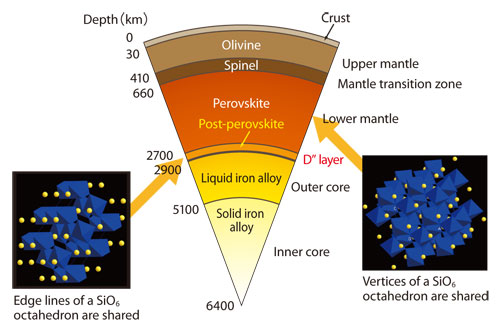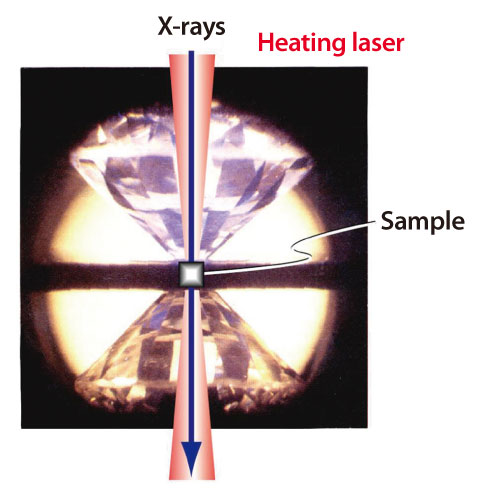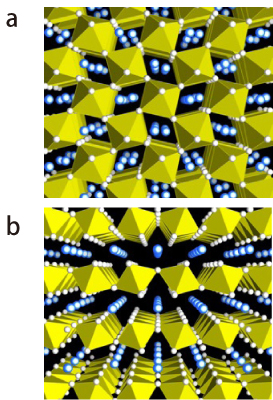Topic 21: Determining the Structure of the Post-Perovskite Phase
Reproducing Earth's Deep Interior Conditions to Unravel its Structure
The structure of Earth's deep interior can only be explored by measuring seismic waves or conducting laboratory experiments that reproduce conditions similar to Earth's deep interior. However, a boundary layer region between the mantle and outer core, which exists 2,900 km underground, is at extraordinarily high pressure (>125 GPa: GPa = 109 Pa = ~10,000 atoms) and temperature (>2,200 °C) conditions, which are beyond imagination. Thus, reproducing such conditions has been extremely difficult. However, this all changed when these conditions were reproduced at the High Pressure Research Beamline (BL10XU) at SPring-8. Now researchers can determine whether an undiscovered mineral exists in Earth's deep interior. This remarkable discovery is invaluable in understanding the structure of Earth's deep interior, and has drawn worldwide attention as an achievement that can greatly advance mankind's understanding of volcanic activities.
Revealing the “Mystery of the D” Layer” using Ultra-High Pressure, Ultra-High Temperature Conditions
The Earth (~6,400 km in radius) is covered by a thin crust that is only several tens of kilometers thick. Underneath this crust is a mantle, which is 2,900 km thick and occupies about 83% of the Earth's volume. The mantle is a lithosphere with a layered structure comprised of the upper mantle, transition zone, lower mantle, and the D” (D double prime) layer (Fig. 1). Beneath the mantle is the outer core, which consists mostly of liquid iron, while the inner core at the center of the Earth is composed of solid iron.
Information about Earth's deep interior has been extracted from the analyses of data obtained from internal seismic waves. Additionally, research on the physicochemical properties of major minerals in the Earth has been conducted. However, because the minerals deep inside the Earth cannot be directly observed, the only feasible method is to conduct laboratory experiments that reproduce conditions equivalent to those found in Earth's deep interior. The major obstacle is the fact that Earth's deep interior is under ultra-high pressure, ultra-high temperature conditions. In particular, the D” layer, which is the lowest layer of the mantle, reaches more than 125 GPa and 2,200 °C, and artificially reproducing such ultra-high pressure, ultra-high temperature conditions is itself technically difficult.
The principal mineral of the D” layer had been tentatively assumed to be MgSiO3 in the perovskite phase, which is a compound of magnesium and silicate, but this assumption has yet to be validated. In the D” layer, the observed velocities of seismic waves vary drastically, and the seismic polarization anisotropy where the velocity depends on the direction of vibration, is significant. Therefore, the distribution of the perovskite is likely non-uniform. Based on existing data, a large part of the lower mantle is occupied by minerals whose main component is MgSiO3; however, the discontinuity and anisotropy of the velocities of the seismic waves passing through the D” layer cannot be explained if this is the case.
To unravel the mystery of the D” layer, Dr. Kei Hirose1) (Associate Professor, Tokyo Institute of Technology, Japan) in collaboration with researchers at SPring-8 officially began to conduct research on the D” layer in 2000.
1) Currently Professor at the Department of Earth and Planetary Science, Graduate School of Engineering, Tokyo Institute of Technology, Japan.

The lower mantle and D” layer were once believed to be comprised of perovskite. However, the existence of post-perovskite in the D” layer found in this research has changed that perception.
Discovering Minerals Hidden in Earth's Deep Interior
The biggest challenge in this research is reproducing the ultra-high pressure, ultra-high temperature conditions of the D” layer in a laboratory. “To achieve these conditions, we had to develop the necessary technologies one by one, which was really time-consuming,” recalls Dr. Hirose. Dr. Hirose and colleagues initially prepared two brilliant-cut diamonds. These two diamonds were placed face-to-face at their tips, and MgSiO3 was inserted between the tips (Fig. 2). Then MgSiO3 was compressed by squeezing these diamonds while exposing this setup to laser irradiation. This experimental system is a laser-heated diamond anvil cell high-pressure generator, and allows researchers to reproduce extremely high-pressure, high-temperature conditions of more than 125 GPa and 2,200 °C, which are impossible with previous techniques.
Their research group installed this laser-heated diamond anvil cell high-pressure generator in BL10XU at Spring-8, and measured the intensity distributions of the scattering and diffraction of X-rays irradiated onto MgSiO3 crystals as the pressure and temperature was increased. The BL10XU can produce 108 times more brilliant X-rays compared to conventional X-ray sources. Such extremely bright X-rays can be utilized to extract sufficient information about the structures and properties from a tiny sample crystal placed in a laser-heated diamond anvil cell.
The information extracted from the pressurized and heated crystal provides data about the phase transition properties, such as the structural changes of MgSiO3 that occur deep within the Earth. In this way, the condition (>125 GPa and >2,200 °C) of the D” layer, which is a boundary between the core and mantle, was reproduced at the BL10XU. Their research revealed that the structure of MgSiO3 under these extreme conditions completely differs from that of perovskite, and they called this new material MgSiO3 “post-perovskite” (Fig. 3). In December 2002, they discovered a new material hidden in Earth's deep interior. Their achievement was published in Science (May 2004) and the crystal structure of MgSiO3 post-perovskite appeared on its cover.
Consistently Explaining Both the Discontinuity and Anisotropy of Seismic Waves
The discovery of this new phase of MgSiO3 led to many new questions. Thus, Dr. Hirose's group then focused on examining the elasticity tensor of the MgSiO3 post-perovskite phase. An elasticity tensor is a set of proportional constants that represent the magnitude of stresses when a mineral is deformed. Additionally, the elasticity tensor is an index of the hardness of a mineral and determines the velocity of seismic waves. However, existing technologies cannot measure the tensor under such ultra-high pressure conditions. To overcome this difficulty, Dr. Toshiaki Iitaka (Scientist, the Computational Astrophysics Laboratory, RIKEN, Japan) and colleagues performed large-scale first-principle electron state calculations using supercomputers based on the experimental results obtained at SPring-8 to determine the elasticity tensors of perovskite and post-perovskite. They revealed that the discontinuity and anisotropy of the seismic waves at the boundary between the core and mantle can be consistently explained if the existence of post-perovskite is assumed. Their finding also demonstrated that post-perovskite exists in the lower part of the D” layer, and was published in Nature (July 22, 2004). Their accomplishment was featured in two prestigious academic journals, Nature (UK) and Science (US).
Upon discovering post-perovskite, the seismic wave structure model of the D” layer, a boundary layer of the mantle convection, has been refined. If the actual state of mantle convection, especially the generation mechanism of mantle upwelling (hot plume) from the bottom of the mantle, is revealed based on this refinement, then the mechanisms of large-scale volcanic activities due to heat transportation from Earth's deep interior toward the surface as well as Earth's environmental changes induced by such volcanic activities can be examined.
These research achievements in the D” layer and post-perovskite have significantly contributed to the development of earth science, and Dr. Hirose received the IBM Japan Science Prize in 2007 for his contributions.

Crystal structure analyses using extremely luminous X-rays were conducted on MgSiO3 samples, which were sandwiched and pressurized by diamonds and heated by laser.

Light blue balls represent Mg2+ ions. Each silicon atom is situated at the center of an octahedron and each oxygen atom is at a vertex.
References
1. M. Murakami, K. Hirose, K. Kawamura, N. Sata and Y. Ohishi; Science, 304, 855 (2004)
2. T. Iitaka, K. Hirose, K. Kawamura and M. Murakami; Nature, 430, 442 (2004)